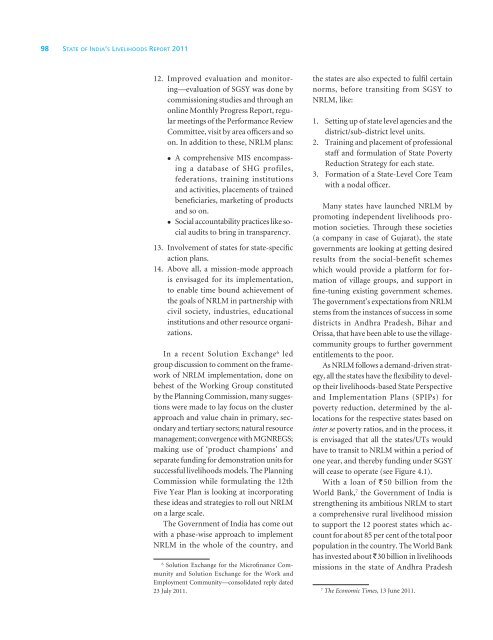SOIL Report 2011 - ACCESS Development Services
SOIL Report 2011 - ACCESS Development Services
SOIL Report 2011 - ACCESS Development Services
- No tags were found...
Create successful ePaper yourself
Turn your PDF publications into a flip-book with our unique Google optimized e-Paper software.
98 State of India’s Livelihoods <strong>Report</strong> <strong>2011</strong>12. Improved evaluation and monitoring—evaluationof SGSY was done bycommissioning studies and through anonline Monthly Progress <strong>Report</strong>, regularmeetings of the Performance ReviewCommittee, visit by area officers and soon. In addition to these, NRLM plans:• A comprehensive MIS encompassinga database of SHG profiles,federations, training institutionsand activities, placements of trainedbeneficiaries, marketing of productsand so on.• Social accountability practices like socialaudits to bring in transparency.13. Involvement of states for state-specificaction plans.14. Above all, a mission-mode approachis envisaged for its implementation,to enable time bound achievement ofthe goals of NRLM in partnership withcivil society, industries, educationalinstitutions and other resource organizations.In a recent Solution Exchange 6 ledgroup discussion to comment on the frameworkof NRLM implementation, done onbehest of the Working Group constitutedby the Planning Commission, many suggestionswere made to lay focus on the clusterapproach and value chain in primary, secondaryand tertiary sectors; natural resourcemanagement; convergence with MGNREGS;making use of ‘product champions’ andseparate funding for demonstration units forsuccessful livelihoods models. The PlanningCommission while formulating the 12thFive Year Plan is looking at incorporatingthese ideas and strategies to roll out NRLMon a large scale.The Government of India has come outwith a phase-wise approach to implementNRLM in the whole of the country, andthe states are also expected to fulfil certainnorms, before transiting from SGSY toNRLM, like:1. Setting up of state level agencies and thedistrict/sub-district level units.2. Training and placement of professionalstaff and formulation of State PovertyReduction Strategy for each state.3. Formation of a State-Level Core Teamwith a nodal officer.Many states have launched NRLM bypromoting independent livelihoods promotionsocieties. Through these societies(a company in case of Gujarat), the stategovernments are looking at getting desiredresults from the social-benefit schemeswhich would provide a platform for formationof village groups, and support infine-tuning existing government schemes.The government’s expectations from NRLMstems from the instances of success in somedistricts in Andhra Pradesh, Bihar andOrissa, that have been able to use the villagecommunitygroups to further governmententitlements to the poor.As NRLM follows a demand-driven strategy,all the states have the flexibility to developtheir livelihoods-based State Perspectiveand Implementation Plans (SPIPs) forpoverty reduction, determined by the allocationsfor the respective states based oninter se poverty ratios, and in the process, itis envisaged that all the states/UTs wouldhave to transit to NRLM within a period ofone year, and thereby funding under SGSYwill cease to operate (see Figure 4.1).With a loan of ` 50 billion from theWorld Bank, 7 the Government of India isstrengthening its ambitious NRLM to starta comprehensive rural livelihood missionto support the 12 poorest states which accountfor about 85 per cent of the total poorpopulation in the country. The World Bankhas invested about `30 billion in livelihoodsmissions in the state of Andhra Pradesh6Solution Exchange for the Microfinance Communityand Solution Exchange for the Work andEmployment Community—consolidated reply dated23 July <strong>2011</strong>.7The Economic Times, 13 June <strong>2011</strong>.














